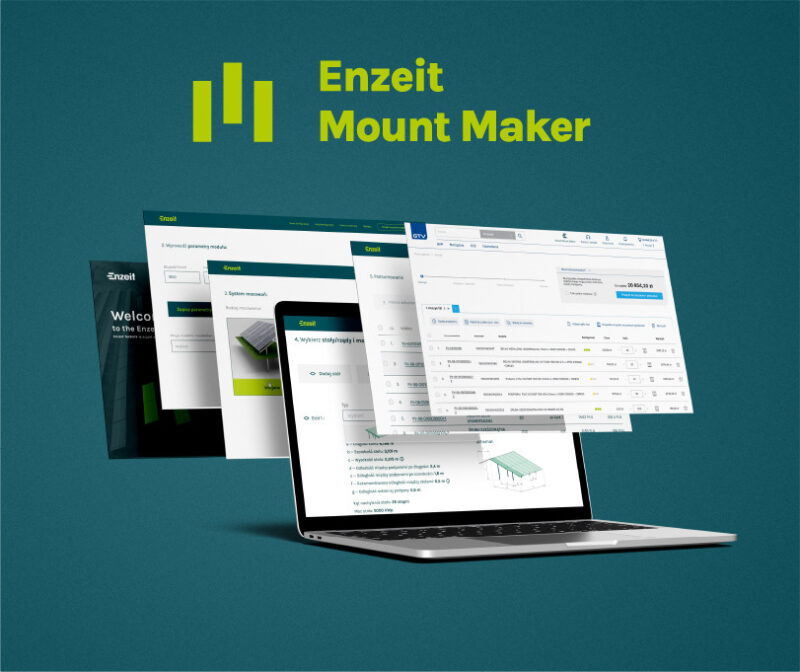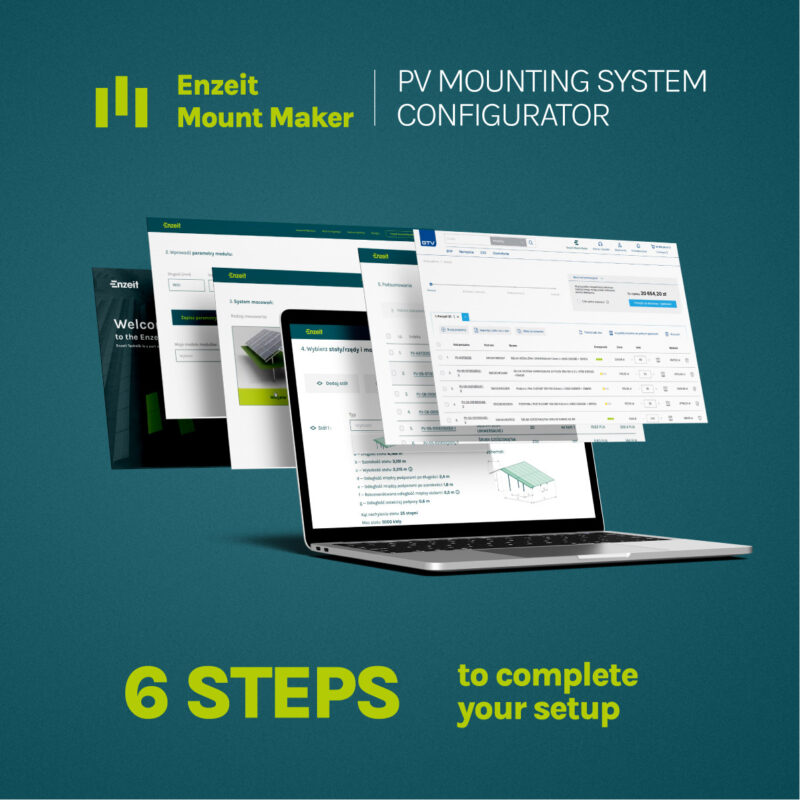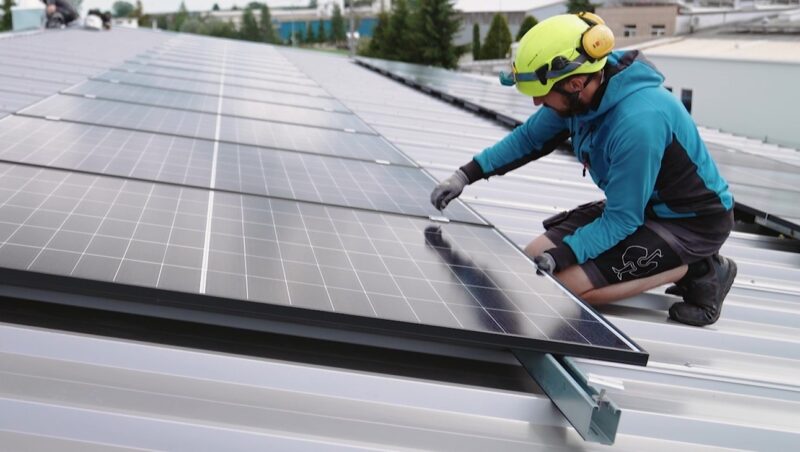Energy storage facilities are becoming an increasingly popular solution among owners of photovoltaic installations. They allow the storage of surplus electricity, which contributes to greater energy independence and efficiency of the entire system. Thanks to the storage, it is possible to better manage the generated energy, which translates into higher self-consumption and reduced costs of purchasing energy from the grid. Does energy storage always make sense? How does photovoltaics with an energy bank work? Does photovoltaics with energy storage pay off? These and other questions will be answered in the following article.
What is an energy storage?
Energy storage is a system for storing electricity for use at times of increased demand or reduced production. It includes batteries, control systems and energy converters that ensure optimal management of charging and discharging processes.
Modern energy storage is often based on lithium-ion technology, although other solutions, such as lead-acid or flow batteries, are also used. An important function of the storage facility is to increase the efficiency of energy self-consumption, which reduces the need to feed surpluses back into the grid and minimizes the impact of tariff changes on user costs.
In addition, in the event of a power grid failure, the storage facility can act as a source of emergency power, increasing household energy security. Its use is particularly beneficial in areas exposed to unstable power supplies and where users strive for full energy independence.
Advanced energy management systems allow intelligent control of the flow of electricity, which optimizes its consumption and extends the life of the storage. The growing popularity of energy storage is also due to rapidly expanding subsidy programs and changes in prosumer billing systems, which make this type of solution increasingly cost-effective.
How does energy storage work with solar PV?
Energy storage at a photovoltaic plant works by converting and storing excess electricity generated by the photovoltaic plant, and then releasing it when demand increases or production is reduced.
A key component of the system is the energy management system (BMS- Battery Management System), which controls the charging and discharging processes of the batteries, optimizing their performance and ensuring long life. In on-grid systems, excess energy is directed to storage instead of the grid, allowing for increased self-consumption and independence from dynamic electricity tariffs. In off-grid systems, the storage facility serves as the main power source, providing a continuous supply of electricity without the need for a grid.
Importantly, modern energy storage facilities use smart management technologies that analyze consumption forecasts and weather conditions, adjusting how energy is managed. These systems can also work with dynamic energy tariffs, allowing batteries to be charged during hours of low energy prices and used at times of peak grid load. It is worth remembering that the efficiency of storage depends on the efficiency of the charging and discharging cycle, as well as the type of batteries used. Lithium-ion energy storage is characterized by high efficiency and a high number of duty cycles, which makes it the most widely used solution today.
What are the advantages of energy storage with photovoltaics?
- Increasing self-consumption of energy
One of the key advantages of energy storage is to maximize the use of energy produced by the PV system for self-consumption. In systems without storage, excess energy is given back to the grid, often at unfavorable rates, and then purchased again, reducing the profitability of the overall system. Energy storage avoids this process, increasing the degree of direct consumption by the user.
- Independence from the electricity grid
Having energy storage reduces dependence on electricity grid operators. For households equipped with off-grid or hybrid systems, energy storage allows them to function even if the grid fails. This is particularly important in areas exposed to frequent power outages.
- Protection against rising energy prices
Rising electricity prices are a significant burden on households, farms or businesses. Energy storage facilities significantly reduce the cost fluctuations associated with dynamic changes in tariffs, allowing stored electricity to be used during peak demand hours, when prices are highest. This solution provides greater predictability of operating costs.
- Possibility of emergency power supply
Another advantage of energy storage is that it can be used as an emergency power supply. In this way, key devices such as alarm systems, heat pumps or medical equipment are protected. Modern systems can automatically switch to island mode (off-grid), allowing uninterrupted energy supply to key consumers.
- Optimization of energy costs
Energy storage systems can work with dynamic tariffs, which means that batteries can be charged during hours when electricity is cheaper and used at times of higher prices. Such a solution guarantees significant savings in the long term.
- Support for grid stability
Indiscriminate use of renewable energy sources can cause congestion and generate instability in the electricity grid. Energy storage facilities help balance the system by storing surplus energy locally and gradually releasing it, which relieves the strain on the grid and contributes to its stability.
- Ability to integrate with intelligent energy management systems
Advanced energy management systems allow intelligent control of storage, adjusting charging and discharging processes according to weather conditions, projected energy consumption and energy market prices. This allows the user to maximize savings and efficiency of the entire system.
- Green benefits
Energy storage supports decarbonization and the development of renewable energy sources, reducing the need to use coal and gas-fired power plants during peak hours. This solution contributes to reducing CO₂ emissions and improving air quality, supporting global climate goals.
- Long-term savings
Although the initial cost of installing energy storage for photovoltaics is high, the long-term savings from reduced dependence on the grid and optimization of energy consumption can make the investment worthwhile. Combined with subsidy programs and rising energy prices, the return on investment in energy storage can be faster than initially expected.
- Scalability of the system
Modern energy storage can be scaled and adapted to the user’s changing energy needs. Thanks to their modular design, it is possible to add more storage units, allowing you to gradually increase capacity and flexibly adapt the system to growing energy demand.
What are the disadvantages of energy storage?
Despite the numerous advantages, energy storage units also have some disadvantages. First of all, there are high purchase and installation costs, which can be as high as tens of thousands of zlotys. In addition, the lifespan of batteries is limited, which means that they need to be replaced after a few or several years. Energy storage also involves some efficiency losses, as the process of charging and discharging batteries is not 100% efficient. The economic aspect is also worth noting. Not all households will find this investment profitable – especially if the energy billing system favors giving the surplus back to the grid.
Does energy storage make sense?
Whether energy storage makes sense depends on individual user conditions. Let’s take a closer look at the key factors:
- Analysis of the energy consumption profile
Evaluating whether an investment in energy storage makes sense should start with an analysis of the energy consumption profile of a household or business. If most of the energy is used during the day, when the photovoltaic system generates electricity, storage may not be necessary. On the other hand, if consumption is mainly in the evening and night hours, when energy production from the panels is limited, storage can significantly increase self-consumption and save money.
- Energy independence and emergency protection
One of the main reasons investors opt for energy storage is the desire for independence from electricity suppliers. In areas prone to frequent power outages, energy storage can act as an emergency power supply, ensuring that domestic or production equipment continues to operate. In hybrid systems, where the storage cooperates with the grid, the user can dynamically manage power consumption depending on current tariffs and own demand.
- Optimization of energy costs
In households using net-billing or dynamic tariffs, energy storage allows electricity to be stored during hours when it is cheapest and used at times when the highest
- Financial conditions and payback time
The cost of purchasing and installing energy storage for photovoltaics is another key factor affecting its profitability. Although battery prices are steadily falling, they still represent a significant expense. Therefore, the decision to invest should be preceded by a return on investment (ROI) analysis, taking into account the cost of installation, savings on energy bills and available subsidy programs.
- Supporting the stability of the electricity grid
In the context of the energy transition and the growing share of renewable energy sources, energy storage facilities are playing an increasingly important role in stabilizing the electricity grid. In the future, they can be used to provide services to grid operators, such as by mitigating peak energy demand.
Photovoltaics with energy storage – is it worth it?
The decision to purchase energy storage should depend on several key factors. First of all, it is worthwhile to analyze the structure of energy consumption and the way of accounting for surpluses. In systems where the sale of energy to the grid is unprofitable or limited by regulations, the storage allows for greater independence from changing tariffs and discount schemes. An additional advantage is the stability of power supply – the user can use the energy stored in the batteries in case of power outages from the grid.
Technological aspects are also worth considering – modern energy storage facilities are equipped with intelligent management systems that optimize the charging and discharging process, which increases their operational efficiency. The forecasts for rising energy prices are also not insignificant, which can make the investment in storage more profitable in the long term. In addition, it is worth examining the available subsidies and preferential financing terms, which can significantly reduce the cost of purchasing and installing a storage facility, accelerating the return on investment.
Does photovoltaics with energy storage pay off?
In 2023, the average cost of a 10 kWh energy storage was about 30-40 thousand zlotys, but it is predicted that by 2026 these prices could fall by another 10-20% thanks to technological advances and increasing scale of production. At the same time, electricity prices in Europe have risen by about 30% over the past five years, making energy storage increasingly cost-effective.
In addition, subsidy programs such as “My Current” and “Clean Air” are available in Poland, which allow subsidies of up to 50% of the value of the energy storage, significantly reducing the initial cost of the investment. Market analyses indicate that for photovoltaic installations with energy storage, the payback period can be from 8 to 12 years, depending on the degree of self-consumption and local electricity tariffs. The greater the proportion of energy consumed locally, the faster the return on investment.
It’s also worth noting the regulatory aspects – in some European countries, fees are being introduced for returning surplus energy to the grid, making electricity storage more profitable than selling energy at low rates. Therefore, it can be predicted that in the coming years energy storage will be a standard component of modern photovoltaic systems.
Energy storage with photovoltaics – summary
Let’s ask ourselves again – does energy storage make sense? The answer to this question depends on a number of factors, such as the energy consumption profile, the availability of subsidies, as well as future energy market regulations. Without a doubt, photovoltaics with an energy bank is a solution that increases self-consumption and independence from the grid, but requires a larger initial investment. It is crucial to understand how photovoltaics with energy storage work and what the long-term financial and operational benefits are. The decision to choose a system – photovoltaics with or without energy storage – should therefore be based on a thorough analysis of the economics and future energy price trends.




